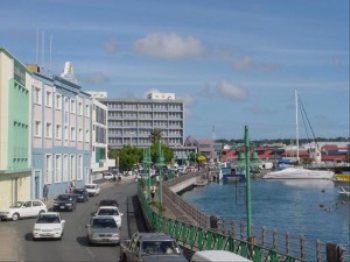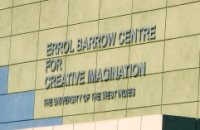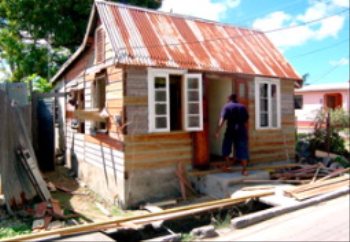Bridgetown Barbados

|
Bridgetown
After our tour around Mount Gay Rum they paid for our taxi into Bridgetown, for some reason I have always wanted to say "I have been to Bridgetown Barbados".
An aerial view, Nelson's Statue and Parliament building. History Although the island was totally abandoned or uninhabited when the British landed here, one of the few traces of indigenous pre-existence on the island was a primitive bridge constructed over the Careenage area's swamp at the centre of Bridgetown. It was suspected that this bridge was created by a people indigenous to the Caribbean, the Arawak. Upon finding the structure the British settlers began to call what is now the Bridgetown area, Indian Bridge. It is widely believed that the Arawaks were driven from Barbados to the neighbouring island of Saint Lucia, during an invasion by another people indigenous to the region known as the Caribs. Eventually after 1654 when a new bridge was constructed over the Careenage by the British, the area became known as The Town of Saint Michael and later as Bridgetown, and the final name stuck. Bridgetown is the only city outside continental North America that George Washington visited. (George Washington House, the actual house where he stayed, is now part of the Garrison Historic Area)
From a Town into a City In 1824 Barbados became the seat of the Anglican 'Diocese of Barbados and the Leeward Islands'. Due to this the Saint Michael's Parish Church became raised to the status of Cathedral, in so doing the elevation meant that thereafter Bridgetown would be conferred with city status. In December 1925 a committee sought to petition the King for a Royal Charter of Incorporation to devise local government in the city. The plan stated the desire for Bridgetown to be run by a Mayor, 8 Aldermen, 12 Common councillors, a Town Clerk, a Headborough or Chef Constable, and such other officers as would be deemed necessary. It was proposed that the island's House of Assembly should seek to Incorporate the city instead of utilising Royal Charter. Some time later in 1842 Royal Letters Patent under which Barbados, Trinidad, Tobago, Grenada, Saint Vincent and Saint Lucia were split into separate diocese decreed that henceforth the Town of Bridgetown should be called the City of Bridgetown. It was not until 1958 when the Local Government Act was passed in Barbados. Within the act called for separate administration for the city. The act called for a Mayor, 6 City aldermen, and 12 City Councillors -- of which 4 serve each of the 3 Wards in the City.
The Coat of Arms of Barbados, The national flag and Bridgetown Coat of Arms. On 20 September 1960 a grant of Arms was conferred upon the City by the Royal College of Arms in London. The Armorial bearings for the City of Bridgetown were designed by the late Neville Connell, the then director of the Barbados Museum and Historical Society along with H.W. Ince the Honorary Secretary of the Society.
Toward the bridge, Broad Street, from the esplanade. Local government in Barbados was established but not for long, the late E.D. Mottley served as the city's first and only Mayor under the Act. In April 1967 the system of Local Government Councils was dissolved and replaced by an Interim Commissioner for Local Government. The Corporation of Bridgetown thus ceased to exist, and its records and paraphernalia were deposited in both the Government Department of Archives and in the Barbados Museum and Historical Society. Today Bridgetown and surrounding constituencies are administered by members of Barbadian parliament. Amalgamation of the Governor with the Windward Islands. From 1800 until 1885 Bridgetown served as the main seat of Government for the former British colonies of the Windward Islands. During this period the resident Governor of Barbados also served as the Colonial head of the Windward Islands. After the Government of Barbados officially exited from the Windward Island union in 1885, the seat was moved from Bridgetown to St George’s on the neighbouring island of Grenada. Barbados has been governed by the Barbados Labour Party (BLP) for the last thirteen years, commonly called the "Owen Arthur Administration". Prime Minister Owen S. Arthur was chosen from among leaders around the globe to deliver the William Wilberforce lecture on the 200th Anniversary of the Abolition of the Atlantic Slave Trade.
Events Amongst the breathtaking landscapes, and the fresh look of the city; Barbados attracts many investors from various fields. The 2007 ICC Cricket World Cup tournament attracted thousands of visitors to the island and was a very prosperous event. The final match was played on Saturday April 28th, 2007. Cricket here is without understatement a religion.
For a city of its size, the Greater Bridgetown area is home to several prestigious educational institutions. The city serves as the seat of one of the three campuses of the University of the West Indies in the northern suburb of Cave Hill. The campus sits on a bluff offering a spectacular view of Bridgetown and its port. The Barbados Community College is located three miles east of the Central Business District in a suburb known as "The Ivy", while the sprawling campus of the Samuel Jackman Prescod Polytechnic is located just beyond the eastern limits of the city in a suburb known as "The Pine". In addition, the city houses such distinguished secondary schools as Harrison College, Combermere and The St.Michael School. The University attracts foreign students from far flung countries.
We decided, if you have to suffer studying, this is the place to do it. The schools here have immaculate uniforms, free bus travel and even private schools get 75% sponsorship per pupil from the Government. It is law that education and health is free for all. Each student only has to pay 10 BB$ per year for all books and textbooks.
After my session in Carter's THE fishing tackle shop and a wander all round the town we decided we would try the bus. You put 1.5 Barbadian dollars each down a slot next to the driver, he can give no change. It doesn't matter how far you are going, that's the fare. There is no FULL on the bus. At best I counted 15 standing at worst 28. Our ride, we knew was going to be just over the hour, for three quarters no one got off, just more piling on. The bus spared no horses and each time anyone wanted to get on they flagged him down, to get off, ring the bell. He must get through a set of brake shoes a week. It was still over-flowing when we got off at Port St Charles, having stood the whole way. Compared to the £30 taxi - we were happy to 'give it a whirl'. On the way we had seen funny little wooden houses they are called: Chattel House is Barbadian slang for a small wooden house that working class people would occupy. The term goes back to the plantation days when the home owners would buy houses designed to move from one property to another.
The word "Chattel" means movable property so the name was
appropriate. Chattel houses are set on blocks rather than being anchored into
the ground. In addition, they are built entirely out of wood and assembled
without nails. This allowed them to be disassembled (along with the blocks) and
moved from place to place. This system was necessary historically because home
"owners" typically did not own the land that their house was set on. Instead,
their employer often owned the land. In case of a landlord tenant (or
employer/employee) dispute, the house could be quickly moved to a new property.
Although the term is strongly associated with Barbados, it is also used as a
legal term in Trinidad (e.g. CHAPTER 59:54 LAND TENANTS ACT and Maharaj v.
Constance 1981) and other islands. Chattel houses are still in use on several
West Indian islands. Nowadays many of them are built on
permanent foundations and have been extended to meet the needs of a modern day
family.
   Some of these little houses are stunning,
simple and brightly painted, others have had a "bad hair day"
 We got off the bus just as it started to
gently rain, by the time we had walked to the tender it was throwing it down, we
got back to Beez soaked to the gusset, stripped in the cockpit, went in for beef
jerk and a bed time toddy, well you just have to in Barbados.
ALL in ALL a great day
out.
|


























